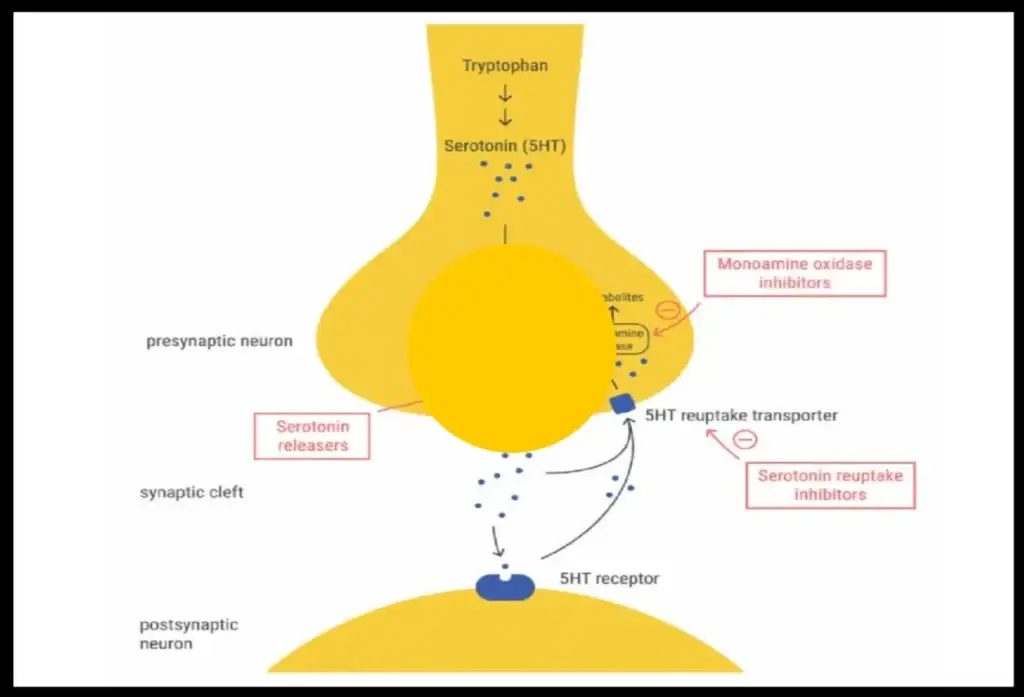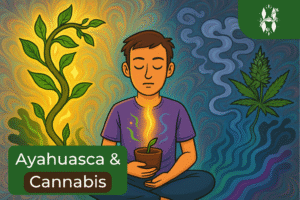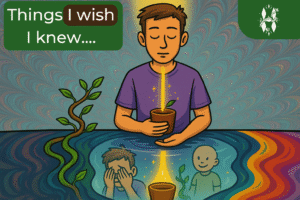Ayahuasca, an ancestral medicinal brew of the native peoples of the Amazon, has been gaining popularity and use over recent years. Its use in cities, where it was almost impossible to find about 20 years ago, has become increasingly common. This has led to more frequent research on its components and has sparked interest within the scientific community regarding its potential therapeutic uses, considering the numerous reports about its benefits, primarily in the fields of psychiatry and neurology. In the last decade, research on Ayahuasca has been on the rise, especially regarding its main components, DMT (Dimethyltryptamine), and the Beta-Carbolines (Harmine, Tetrahydroharmine, and Harmaline), which has led to a better understanding of the mechanisms of action and its effects at the cerebral level.
Key takeaways:
- The combination of the substances present in the ayahuasca brew allows the modifications in the connections in the brain and produce the experience.
- The main element present in Ayahuasca is DMT, that is a substance like serotonin and has implications in the regulation of social behavior, appetite, circadian rhythm, sleep, attention, anxiety, emotional state, learning process and memory.
- Other substances present in the Ayahuasca are B-Carbolines with anti-inflammatory and antioxidant effects in the human body.
- The neurophysiological effects on the brain caused by ayahuasca show positive effects on mood, cognition and possible therapeutic effects for depressive, addiction disorders and Parkinson’s disease.
Table of Contents
What are the components of Ayahuasca or Yagé?
The main alkaloid substances present in Ayahuasca come from two different plants: the vine Banisteriopsis Caapi, which provides the Beta-Carbolines: Harmine (HAR), Tetrahydroharmine (THH), Harmaline (HML), and the leaves of Psychotria viridis (known as Chacruna), which provide N, N-dimethyltryptamine (DMT). (figure 1). Both components are responsible for producing the psychoactive effects that induce different states of consciousness that aid in the healing of the mind, emotions, and spirit. Let’s talk about each one of them.
Must Read Blog: What is Ayahuasca

DMT and its importance in Ayahuasca
DMT is one of the components present in the brew and has been widely studied because it is a molecule that has a similar structure to serotonin (5-HT). Figure 2
DMT is also classified as an endogenous trace neurotransmitter, which means it is part of the body’s substances that transmit messages between cells and is present in tissues such as lungs and brain but in very low quantities.

What is serotonin and why is it important to know about it?
Serotonin or 5-hydroxytryptamine (5-HT) is a neurotransmitter (a substance used by neurons to communicate with other neurons and with other cells) that is produced in the central nervous system (brain and spinal cord) and in other organs of the body (intestines, platelets). It has implications in the regulation of social behavior, appetite, circadian rhythm, sleep, attention, anxiety, emotional state, learning process, intestinal movements, memory, modulator of the hemostasis (regulation of blood clotting), control of blood pressure and also it is a growth factor which may help in wound healing. Its concentration is reduced under stress.
Therefore, by understanding the functions of serotonin, we can get an idea of the brain effects of the beverage.
How does serotonin affect the brain?
There are at least 14 different types of serotonin receptors identified in the brain and each receptor subtype has specific functions with different signaling pathways, some receptors can have inhibitory or excitatory effects on neurons.
There are some cells called the neurons of the raphe nuclein, which are the main sources of 5-HT in the brain; from there, the neurons form different pathways. (Table 1)
Ayahuasca, DMT and serotonin, what about them?
Ayahuasca contains DMT among its components, which is a substance that acts on the same parts of the brain as serotonin (5-HT1a, 5-HT2a, 5-HT2c neuronal receptors). We must consider that its other components (Beta-Carbolines) can also act as neurotransmitters, as they can either bind directly to the stimulated brain area (neuronal receptor) or inhibit the degradation of serotonin (increasing the availability of serotonin for further stimulation) by inhibiting monoamine oxidase-A (MAO-A), allowing for greater availability of noradrenaline and serotonin in the brain.

Neural communication to further understanding!
We will see a typical example of neuronal communication through serotonin, not forgetting that this same function can be carried out by DMT.
In the following diagram, we can see two neurons communicating. The first one contains serotonin molecules inside it (acting as messengers) and is called the presynaptic neuron, while the second is called the postsynaptic neuron. Serotonin is released into the space between the two neurons, which is called the synaptic cleft, and from there, it binds to the 5-HT receptors on the surface of the postsynaptic neuron, producing stimulation.
In the image, we can also observe that in the first neuron, there are structures responsible for trapping the serotonin that remains free in the space and carrying the excess back to the presynaptic neuron to deliver it to monoamine oxidase (MAO) for its elimination. (Figure 3)

What about the other compounds in Ayahuasca? Let’s find out what Monoamine Oxidases are!
Monoamine oxidases (MAO) are a group of enzymes in the body that are responsible for controlling the availability of the neurotransmitters serotonin, dopamine, and noradrenaline, therefore, they also have effects on DMT when it is ingested orally.
There are many types of MAO inhibitors, and some are still used as antidepressants, as it has been evidenced that their imbalance (too much or too little MAO activity) is thought to be responsible for several neurological disorders. For example, unusually high or low levels of MAOs in the body have been associated with depression, schizophrenia, substance abuse, attention deficit disorder and migraines.
However, Ayahuasca contains Beta-Carbolines among its components, which are the alkaloids responsible for temporarily blocking the action of MAO, and it is this inhibition that allows DMT to reach the brain, leading to the elevation of serotonin, noradrenaline, and dopamine levels.
Ayahuasca and MAO inhibitors
Multiple studies have demonstrated the presence of MAO inhibitors in Ayahuasca, namely the so-called Beta-Carbolines: Harmine, Tetrahydroharmine, and Harmaline, which are found in higher concentrations in the beverage. It is thanks to these substances that DMT can enter the brain, exerting its effect on serotonin receptors.
Research on Ayahuasca has indicated that the combination of Harmine and Tetrahydroharmine may be sufficient to produce the inhibition of the MAO enzyme, with this inhibition being temporary.
How does the Ayahuasca brew affect the brain?

The effects of ayahuasca on the brain are complex and multifaceted. Research on this topic is still ongoing, and the exact mechanisms by which ayahuasca affects the brain are not yet fully understood.
The effect of the brew starts around half an hour after its intake and subsiding within four to six hours, producing exacerbations of sounds and a transient introspective state characterized by dream-like visions with closed eyes (that are different to hallucinations because in that, most people are fully aware of the visual effects), recollection of personal memories, and intense emotions.
This kind of connection may produce changes in the way people perceive reality, for some studies have associated the intake of Ayahuasca with modulation of neuronal plasticity (the capacity of the brain to create new connections with other neurons), one of the main effects in the brain.
If we divided the substances presents in Ayahuasca, we can find that:
DMT, harmaline and tetrahydroharmine have shown antioxidant effects at cellular level, that is, they trap substances that damage cells.
Harmine and Harmaline increases the concentration of Dopamine, which could have benefits in the management of Parkinson’s disease.
Harmine has been shown in some studies to have anti-inflammatory effects in the body by inhibiting internal cellular responses to stimuli such as stress, ultraviolet radiation, bacteria and viruses.
DMT promotes the generation of new neurons (a process called neurogenesis) by activating specific areas of the hippocampus (a zone in the brain) where exists a large number of neural stem cells, therefore, improving learning and spatial memory skills.
DMT has a protective effect on cells against oxidizing agents (those that cause aging in the cells) and effects on myelination process (which is responsible for providing protection to a part of the neurons called axons).
The combination of the substances present in ayahuasca infusion has antidepressant activity; a therapeutic effect usually linked to hippocampal neurogenesis.
At a psychological level, an increase in creativity and creative thinking has been evidenced.
There has also been described a series of subjective experiences involving ethical lessons, leading the individual to establish deep connections with inner self and with the so-called ‘source’, which brings benefits in terms of consciousness, affection, life satisfaction, self-acceptance, and compassion.
Other benefits at the behavioral level involve enhancing introspection, leading to reduced stress levels, improved judgment processing, enhanced internal reactivity, which induces changes in the perception of events, emotions, and cognitive processes, ultimately resulting in improved management of anxiety, panic, depression, hopelessness, and addictions.
As an interesting fact, from a pharmacological standpoint, Ayahuasca does not produce tolerance (a decrease in effects when used repeatedly) nor physiological dependence, as the studies conducted have not evidenced associated psychiatric disorders (withdrawal, tolerance, abuse behavior, and social alterations).
The default mode network and the Ayahuasca
In the brain there is a zone that is called the default mode network. It has multiple functions, which include recognition of the self (autobiographical memories and events, own emotions), thoughts about others (empathizing with the emotions, making judgments about what is fair or not, social interactions), memories about the past, thoughts about the future and consolidation of memories. This part of the brain is important since multiples studies have shown effects of the Ayahuasca in this region.
One of these studies shows that ayahuasca produces a significant activation of the frontal and paralimbic brain regions, increasing blood perfusion in the right hemisphere and activation of the left amydgala and parahippocampal gyrus, which leads to interact with neural systems that are central to introspection and emotional processing.
Another study from Sampedro et al. found post-acute reductions in glutamate and glutamine that lead to neurophysiological modifications in brain regions of the default mode network after ingestion of Ayahuasca, which was correlated with increase in “non-judging” subscale scores, in mindfulness capacities and a rapid and sustained antidepressant effects in treatment-resistant patients, providing an explanation for the described experiential effect of post-ayahuasca “after-glow”.
Neurophysiological studies show a suppression of the inhibitory alpha rhythm in the occipital and parietal cortex, including the posterior cingulate cortex, a key node of the default mode network with a prominent role in self-reflection and consciousness.
Recently, Ayahuasca was found to induce post-acute increases in “decentering” ability, that is, the capacity to observe one’s thoughts and emotions in a detached manner, and to reduce automatic negative judgmental attitudes and inner reactivity. It thus enhanced a series of “mindfulness” capacities traditionally cultivated by meditation schools and that are known to be impaired in many forms of psychopathology.
Conclusion
After conducting a study on the brain mechanisms of action of the compounds involved in Ayahuasca and their function as a neurotransmitter that temporarily increases in connectivity between brain regions and alterations in the activity of brain networks, there is no doubt about the multiple functions and therapeutic potential of this beverage. To date, benefits have been reported in mindfulness, changes in functional and psychological balance, and modulating effects of neuronal plasticity, which translate into improved mood, enhanced cognitive processes, increased introspection, better stress and anxiety management, enhanced impulse control, and improved creativity, not to mention the effects on brain functions such as neurogenesis, myelination, and antioxidant effects at the neuronal level, reaffirming its therapeutic potential to facilitate emotional processing that improves psychological well-being.
References
1. Berger, M., Gray, J. A., & Roth, B. L. (2009). The expanded biology of serotonin. Annual review of medicine, 60, 355-366.
2. Lam, D. D., Garfield, A. S., Marston, O. J., Shaw, J., & Heisler, L. K. (2010). Brain serotonin system in the coordination of food intake and body weight. Pharmacology Biochemistry and Behavior, 97(1), 84-91.
3. Ruffell, S., Netzband, N., Bird, C., Young, A. H., & Juruena, M. F. (2020). The pharmacological interaction of compounds in ayahuasca: a systematic review. Brazilian Journal of Psychiatry, 42, 646-656.
4. Fortunato JJ, Réus GZ, Kirsch TR, Stringari RB, Fries GR, Kapczinski F, et al. Chronic administration of harmine elicits antidepressant-like effects and increases BDNF levels in rat hippocampus. J Neural Transm (Vienna). 2010;117:1131-7.
5. Riba J, Romero S, Grasa E, Mena E, Carrió I, Barbanoj MJ. Increased frontal and paralimbic activation following ayahuasca, the pan-Amazonian inebriant. Psychopharmacology (Berl). 2006;186:93-8.
6. Sampedro, F., de la Fuente Revenga, M., Valle, M., Roberto, N., Domínguez-Clavé, E., Elices, M., … & Riba, J. (2017). Assessing the psychedelic “after-glow” in ayahuasca users: post-acute neurometabolic and functional connectivity changes are associated with enhanced mindfulness capacities. International Journal of Neuropsychopharmacology, 20(9), 698-711.
7. Riba J, Rodríguez-Fornells A, Urbano G, Morte A, Antonijoan R, Montero M, Callaway JC, Barbanoj MJ (2001) Subjective effects and tolerability of the South American psychoactive beverage Ayahuasca in healthy volunteers. Psychopharmacology (Berl) 154:85–95
8. Schenberg EE, Alexandre JFM, Filev R, Cravo AM, Sato JR, Muthukumaraswamy SD, Yonamine M, Waguespack M, Lomnicka I, Barker SA, da Silveira DX (2015) Acute biphasic effects of ayahuasca. PloS One 10:e0137202
9. Vogt BA, Laureys S (2005) Posterior cingulate, precuneal and retrosplenial cortices: cytology and components of the neural network correlates of consciousness. Prog Brain Res 150:205–217
10. Soler J, Elices M, Franquesa A, Barker S, Friedlander P, Feilding A, Pascual JC, Riba J (2016) Exploring the therapeutic potential of Ayahuasca: acute intake increases mindfulness-related capacities. Psychopharmacology (Berl) 233:823–829
11. Morales-Garcia, J.A., Calleja-Conde, J., Lopez-Moreno, J.A. et al. N,N-dimethyltryptamine compound found in the hallucinogenic tea ayahuasca, regulates adult neurogenesis in vitro and in vivo. Transl Psychiatry 10, 331 (2020).
12. Baroffio Irazabal, F. (2023). Caracterización in vitro de los componentes principales de Ayahuasca y su combinación como agentes antioxidantes y neuroprotectores.
13. Gonçalves, J., Luís, Â., Gallardo, E., & Duarte, A. P. (2023). A Systematic Review on the Therapeutic Effects of Ayahuasca. Plants, 12(13), 2573.
14. Muftin, N. Q. (2012). The Effect of Some Organic Compounds on Monoamino oxidase Activity. Al-Nahrain Journal of Science, 15(4), 38-46.
Additional information:
There is a great YouTube Video / Podcast out with Dennis McKenna and Tim Ferris where they go in depth about this topic as well:




